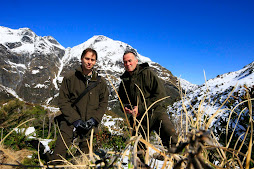The argument of whether deer belong in our forests or not, comes up regularly. Many groups, and educational institutions attempt to inDOCtrinate their members and students with the theory that deer, and some other wild animals, are pests that cause permanent damage to New Zealand forests, and should be eradicated.
Deer populations are low, to very low, in most parts of the country.
However, the unfounded claims, and bias research still roll out on a regular basis, and contradict what is actually happening in our forests.
It is probably not unreasonable to speculate that believers in the "deer cause permanent forest damage" theory have never seen a wild deer, let alone have any experience in the wilderness - at least in regard to getting off the beaten track.
Secondhand stories, and fables that have been passed down through generations have helped develop an "anti-exotic animal phobia", as a visiting zoologist pointed out 53 years ago...
In 1957 a Professor of zoology - Dr. William Graf - visited New Zealand to look at deer populations. His paper is called...
OBSERVATIONS AND COMMENTS ON DEER CONTROL AND WILDLIFE MANAGEMENT IN NEW ZEALAND
The following excerpts (in blue) are from his findings...
 The trip to NZ is part of the overall study of the Hawaiian deer study started on September 1, 1957.
The trip to NZ is part of the overall study of the Hawaiian deer study started on September 1, 1957. This study was initiated as a result of the conflict of interests and opinion as to the desirability
of introducing deer into territorial islands beyond the present range of distribution of the deer i
n Hawaii.
The argument against the introduction of deer into new areas was based upon a number of points. Basically these were as follows...
1/ The current and widely-held belief that "where vegetation develops in the absence of grazing or browsing animals such vegetation will later be unable to withstand grazing and browsing and will quickly be exterminated by grazing and browsing animals."
2/ That wild animals introduced into areas where no such animals have ever been found will result in uncontrollable populations of these animals with a consequent denudation of the vegetation.
3/ The antagonism produced as a result of the introduced deer into any of the presently deer-free islands
was based to a large extent upon information about NZ and its supposed deer population problems.
Professor Graf goes on to say....
The arguments with regard to New Zealand were presented in such volume and so strongly that they could not be ignored. The evidence with regard to New Zealand, however, was so conflicting from the standpoint of known facts about deer populations in other
parts of the world, that the only solution was to go to New Zealand and examine the situation first hand.
The information used was often based on newspaper stories written by obviously uninformed and prejudiced people. The nature of the articles showed obviously an emotional bias by people not trained in recognising evidence, much less in interpreting it. Quite often the wrong species of animal would be involved. It was difficult to accept statements about the uncontrollable numbers of animals when such statements were directly opposed to all experiences with similar or the same species in other parts of the world. Population behavior and relationship to environment follow basic rules which are not likely to be suspended simply because of change in location.
Because of this and the fact that the NZ information did not agree with the evidence which I found in Hawaii, the decision was made to go to New Zealand.
In summary, Dr. Graf makes the following comments...
It was found that there exists in NZ what amounts to an "anti-exotic animal phobia" to an extent that much of the public as well as many government officials do not and cannot view the situation in an objective perspective.
Administration and management of the wildlife resources is widely divided among various departments and agencies in NZ. The result is often one of duplication of work, conflict of interests, philosophies and policies, with the inevitable inefficiency and waste of time and money.
Throughout my visit in New Zealand I was repeatedly informed that "conditions in New Zealand were different." I must emphatically deny that conditions were different from any basic standpoint related to principles of biology or ecology. The basic problems as i found them are no different in NZ than they are in North America, Hawaii or Europe. Only the details vary. The principles that apply to these problems and the problems are the same.
The oft repeated and widely believed statement about "vegetation which develops

in the absence of grazing and browsing animals-" simply does not stack up under close scrutiny.
First of all, where no browsing or grazing animals have been found before the advent of white man and his introductions, the vegetation has been derived almost entirely if not entirely so, from plant families which evolved on mainland areas in the presence of grazers and browsers.
Secondly, that where no grazers or browsers are present the normal genetic process is for random development of all types of variations, some resistant and some not resistant to animal use, and in all degrees of variation. It would be just as logical to postulate that such vegetation will all be highly resistant to animal use as to say it will not be resistant to animal use.
Thirdly, New Zealand vegetation can hardly be considered as a type which developed in the absence of vegetarian animals. The various birds, extinct and present, are to a large extent browsers. The pigeons, parakeets and parrots are leaf and bud eaters.
The best proof of toughness of New Zealand vegetation is the way it has withstood the most ruthless use -man's fire and livestock. Wherever fire and logging use has been discontinued the forest is coming back - and in the presence of deer, sheep and even goats as I saw myself within a few miles of Wellington.
In addition to this, New Zealand has produced some of the finest hedge plants in use today in the United States. If the oft-quoted statement about vegetation evolution in the absence of grazers and browsers is to be taken at face value, one would have to conclude that these hedge plants must have evolved in the presence of wild hedge shearers.
I am left with no choice except to conclude that the information about numbers of deer and their effect upon the vegetation was in error. Certainly the figures about deer do not agree with any possible reproductive capacity, or even potential, of any known deer species.
It's worth pointing out that when Dr. Graf visited New Zealand in 1957, deer numbers were probably 10 times higher than they are now, but the facts remain the same. In many ways, his conclusions are more relevant now, than they were then.
Whether you agree with Dr. Graf's findings or not, there certainly is a thread of "anti-exotic animal phobia" entrenched in New Zealand educational institutions, departmental bodies and lobby groups.
In regard to the consensus on deer populations in our forests -
A study was conducted by W. Fraser for Landcare Research, (Landcare Research series no. 23) which found that 95% of people surveyed would like to a see deer in the back country.
A ministerial paper was also conducted into peoples views on game animals, and of the 4000 respondents, 80% thought these animals were a resource.
It is mis-information and "anti-exotic animal phobias" that are encouraging the unnecessary aerial poisoning campaigns currently used in New Zealand.
If we can find a middle ground, where our wild animals are managed sensibly, and our objectives remain reasonable, then I think we can eventually all start heading in the same direction, and work toward a cleaner, greener, and happier New Zealand.
















